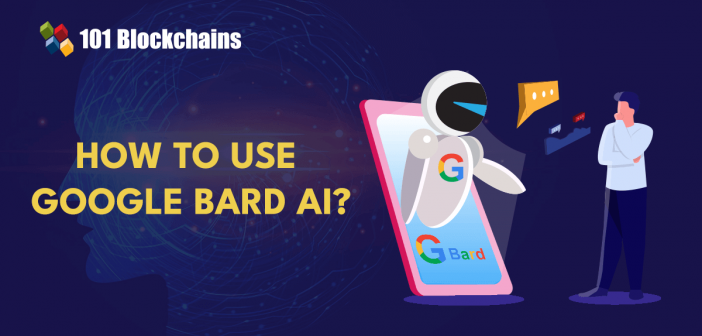Learn how blockchain truly works, master key definitions, and uncover what makes smart contracts so "smart." Dive into the fundamentals, gain valuable insights, and start your blockchain journey today!

- AI & ChatGPT
James Howell
- on September 20, 2023
What is Google Bard and how does it work?
Artificial intelligence or AI is one of the most popular technologies which have gained significant traction in recent times. It has a wide range of applications ranging from helping doctors with earlier detection of diseases to enabling access to information in native languages. If you want to find answers to ‘What is Google Bard,’ then you must know that AI is a crucial tool for helping people, communities, and businesses unlock their true potential. Artificial intelligence also offers multiple new opportunities targeted at improving billions of lives worldwide. Therefore, Google initiated efforts to re-aligning the company with the AI revolution almost six years ago. Google believes that AI could empower the organization to deliver according to their mission of organizing information and ensuring that it is universally accessible and applicable in real-world use cases.
Google has been making significant investments in AI, and the advancements in Google AI alongside DeepMind have proved the same. The fundamentals of Google Bard explained for beginners must also reflect on the fact that the scale of AI computations is growing by 2 times at a gap of six months.
On top of it, large language models and advanced generative AI applications have been garnering the attention of people worldwide. Interestingly, the Transformer research project and developments in diffusion models by Google support many popular generative AI applications. Let us unravel more information about Google Bard and its working mechanisms to understand its potential.
Definition of Google Bard
Before you try Google Bard, you must learn about the identity and functionalities of the tool. Google Bard is a generative AI tool by Google for simulating human conversations. It utilizes the power of machine learning and natural language processing to achieve its objectives. Google Bard supports Google search. Bard also provides flexibility for integration in websites, applications, and messaging platforms for offering natural language responses to user queries.
Generative AI applications, such as ChatGPT, DALL-E, and Midjourney, have emerged as popular trends in the world of technology. Some of them help in generating text, while some are useful for generating new images, video, and audio files. Google Bard has been tailored as a conversational AI chatbot for responding to human queries with a natural and interactive approach.
Another important highlight in the definition of Google Bard is the use of large language models. It is important to note that Google Bard use large language models, which are neural networks trained on large amounts of text for specializing in processing natural language. One of the common concerns about ChatGPT is the fact that it uses training data prior to September 2021.
Google Bard has also been under scrutiny by the tech community for similar issues in its working mechanism. However, Bard would have an additional advantage with the help of Google Search integration, which could offer data regarding current events. Therefore, the AI chatbot could offer the advantages of external data alongside the base training for large language model training.
Learn the fundamentals of AI applications in business use cases with AI For Business Course
Did Google Launch Bard for Competing with ChatGPT?
Some people point out that the release of Google Bard might have been a rushed attempt at competing with ChatGPT. On the contrary, Google has been working on AI models before OpenAI and has established the foundations for large language models alongside ChatGPT itself. Google launched the Transformer deep learning model for public access in 2017. Interestingly, Google Bard has become one of the top priorities for the Google team.
The review of Google Bard examples would show that it has introduced many additional features at a steady pace. Recently, Google has restructured the Assistant team to introduce more AI specialists for continuous development of Google Bard. Most important of all, you can find a changelog that Google Bard maintains continuously. Even if you find many similarities between ChatGPT and Google Bard, the development of Bard started a long time ago.
Want to develop the skill in ChatGPT to familiarize yourself with the AI language model? Enroll now in ChatGPT Fundamentals Course
Meaning of Google Bard
The term ‘Bard’ is definitely an interesting highlight of the AI chatbot introduced by Google. As a matter of fact, the word means poet or storyteller, such as the Bard of Avalon, William Shakespeare. The name fits perfectly on Google Bard, particularly on the grounds of its linguistic capabilities.
In addition, the origins of Google Bard explained in detail also reflect on the geeky aspects behind the name. Bards are one of the types of characters in Dungeons and Dragons. Interestingly, the characters inspired an old game known as The Bard’s Tale, which subsequently led to the development of many other similar games.
Working Mechanism of Google Bard
The most important highlight in the work of Google Bard is the Language Model for Dialogue Applications, or LaMDA. As a matter of fact, Google Bard is a lightweight version of the LaMDA training model. LaMDA is a type of large language model which utilizes training on datasets featuring web data and public conversations.
The explanations for ‘how does Bard work’ would reflect on the intention of Google behind the design of Bard. Google envisions the application of Bard as a supplement for the Knowledge Graph Cards visible in Search. Knowledge Graph Cards could provide the definition of a word or an overview of a place or person. In such cases, Bard could help in answering NORA or No One Right Answer questions.
How does Google Bard provide responses to the questions no one could answer on the web? The responses to ‘What is Google Bard’ classify it as an AI chatbot. Therefore, it is reasonable to assume that it follows the same working mechanism as other popular alternatives, such as ChatGPT.
However, Google Bard utilizes a different large language model with LaMDA language models for understanding user queries and the context. The foremost highlight of LaMDA is the inclusion of human conversations in training datasets for the model. As a result, Google Bard could understand the colloquialisms and simple nuances which might go undetected by search engines.
Subsequently, Google Bard extracts information from the web to generate an answer. In the next step, Google Bard structures its response in the form of conversational interaction you can expect from another person. You should remember that LaMDA model plays a vital role in structuring the responses.
Want to learn about the ChatGPT Cheat Sheet? Check here for a detailed guide on The Ultimate ChatGPT Cheat Sheet now!
Does LaMDA Improve the Effectiveness of Google Bard?
LaMDA, or Language Model for Dialogue Applications, serves the functionalities of a large language model. However, the advantage of LaMDA is the training dataset which includes public conversations and web data. The concerns regarding similarities between ChatGPT applications and Google Bard use cases have been one of the notable topics of debate. Interestingly, you can find two crucial factors in the training of LaMDA, which validates its role in powering up Google Bard. LaMDA ensures safety and groundedness in its training process, which serves valuable advantages for users.
- LaMDA achieves safety through tuning with data that has been annotated by crowd workers.
- On the other hand, the groundedness aspect points to how LaMDA model grounds itself with the help of facts drawn from external knowledge sources. You should remember that external sources of knowledge are accessible through search functions for information retrieval.
New users who want to try Google Bard must also learn about the important metrics for evaluation of LaMDA outputs. The three distinct metrics employed by Google for evaluating outputs by the LaMDA model include sensibleness, interestingness, and specificity.
- Sensibleness refers to the evaluation of whether a specific answer by LaMDA makes sense or appears irrelevant.
- Interestingness of a LaMDA output reflects on whether the output is insightful or inspires curiosity.
- Specificity provides an indication of whether the answer is generic or vague, or relevant to the context intended by the user.
Furthermore, Google Bard examples can help you identify that the three metrics have been ratified by crowdsourced reviews. According to the LaMDA research paper, crowdsourced reviews alongside the capabilities for fact-checking with a search engine improve the effectiveness of Google Bard.
Aspiring to become a certified AI professional? Read here for a detailed guide on How To Become A Certified AI Professional now!
What are the Other Concerns Regarding Working of Google Bard?
Some of the other important concerns about the working of Google Bard reflect on the accessibility and usability. Google had announced that it had removed the waitlist for Bard, thereby opening it up for public use. The previous waitlist of Google Bard opened on March 21, 2023, following which Google allowed a limited number of users in USA and UK to use Bard.
Another important aspect in the working of Google Bard explained for beginners would point at usability. Google Bard supports more than 40 languages and plans on introducing new languages in the future, thereby ensuring that users can access Google Bard functionalities in their native languages. On top of it, the usability factor of Google Bard is improved with the help of a recent update, which helps in including images in the answers. The images are extracted from Google and served alongside the responses of Google Bard to provide a better explanation.
Want to understand the importance of ethics in AI, ethical frameworks, principles, and challenges? Enroll now in Ethics Of Artificial Intelligence (AI) Course
How Does Google Bard Improve Everyday Products with AI?
Google has been experimenting with the use of AI to improve its search capabilities and value advantages for billions of users worldwide. One of the first transformer models by Google, BERT, served revolutionary results in understanding the nuances of human language. In 2021, Google introduced the MUM model, which offers 1000 times better results than BERT. The MUM model features multi-lingual comprehension features, which can identify crucial moments in videos for providing critical information, such as crisis support in multiple languages.
The latest breed of AI technologies by Google, such as LaMDA, PaLM, and MusicLM, have been improving on existing models. Apart from the Google Bard use cases for conversational interactions, the new AI models have developed innovative approaches for engaging with information. As of now, Google is working on introducing the functionalities of these AI models into its Search feature. Google wants to capitalize on the capabilities of AI to understand information better alongside transforming it into useful insights with efficiency.
People all over the world look up to Google for answers to questions that they come across in their everyday lives. However, user behavior on Google has been changing radically as people seek insightful responses. Users want to look for different types of opinions and perspectives in their search queries.
The review of ‘What is Google Bard’ shows that the tech giant has been successful in leveraging AI technology to meet new user expectations. Furthermore, AI could help in synthesizing insights on questions for which you could not find a convincing right answer. In the near future, users could find AI-powered features in Google Search, which could help in refining complex information alongside multiple perspectives to present them in easily understandable formats.
Take your first step towards learning about artificial intelligence through AI Flashcards
Benefits of Google Bard for Developers
The capabilities of Google Bard for revolutionizing Search and other features of Google indicate promising advantages for users. At the same time, it is also important to reflect on the possibilities for developers to capitalize on Google Bard for AI innovation. Developers could leverage the AI technologies of Google by developing on top of the best models by Google.
As a matter of fact, Google announced that it would onboard individual creators, businesses, and developers to try the Generative Language API. The understanding of ‘how does Bard work’ serves as valuable insights on how Google could achieve such improvements. Furthermore, Google has also revealed plans for developing a collection of APIs and tools that could help in creating innovative AI applications.
Want to learn about the fundamentals of AI and Fintech? Enroll now in AI And Fintech Masterclass
Bottom Line
The introduction to Google Bard explained the different ways in which it is different from the popular AI chatbot, ChatGPT. One of the foremost highlights of Google Bard is the LaMDA language model, which offers better results than GPT models. The LaMDA model has been trained on web data as well as public conversations. Therefore, it can ensure improvement in factual accuracy alongside facilitating a conversational style.
On top of it, you should also note that Google plans on using Bard to transform user experiences in Search. However, Google Bard is still in the stages of infancy. It would require more time for continuous development to introduce new features. Start learning more about the use cases of Google Bard and how it can transform the AI landscape now.






